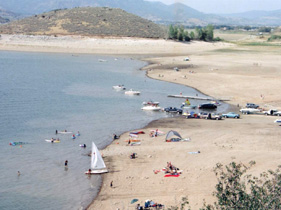Drought Impacts On Water Quality
Utah suffers fourth year of less than normal precipitation
Florence Reynolds
August 19, 2002
|
Since flowing streams are impacted by runoff from non point sources of pollution; such as oil drippings from cars on the road or fertilizer washed from lawns, stream waters may contain higher concentrations of foreign material during a drought. The lack of precipitation during a drought allows the accumulation of these materials on the roads and land surfaces. However, after a significant rain event, the increased concentration of pollutants that wash into the streams may require more aggressive water treatment to maintain water quality. Low water levels mean higher temperature water and the potential for algae growth increases. Streams that receive wastewater returns may find higher concentrations of that wastewater in them, impacting their microbial quality.
Reservoir sources are impacted in much the same way as the stream flows. Low water levels increase the concentration of salts and nutrients in reservoirs. Warm, shallow water promotes the growth of algae. The accumulated sediments on the floor of the reservoir areas release nutrients that stimulate the growth of additional plant life. Water currents and a phenomena called “reservoir turnover” disturb the sediment material (including declaying organics that settle to the bottom of the reservoir) , increasing suspended solids within the body of water. All of these factors may contribute to changes in the taste and odor in the water.
The problems don’t stop there. The exposed lake sediments in the larger beach areas that are normally under water may develop rooted vegetative growth, but when the lake levels comes back after the drought, the vegetation is inundated and dies. Dead and declaying plants release chemical compounds that even at very low levels make the water taste musty or fishy. Although it is possible to remove these taste and odor compounds at the water treatment plant, it is possible that it may not be detected until it reaches the water distribution system as the water ages. Taste and odors are not harmful to our health, but can be aesthetically displeasing. Water consumers should notifiy their water utility when they notice these conditions.
Ground water, wells and springs, are also impacted during a drought. With the decrease in surface water supply, wells are drawn on more heavily than normal, pulling down the underground aquifer. Shallow private wells and springs may suddenly go dry, putting property owners that depend on them out of water. Deep wells normally have a higher mineral content than the surface waters. Customers may notice an increase in the minerals in their municipal tap water. Increased minerals cause hard water spots on dishes and glassware, increase the scale on shower stalls, toilets and faucet fixtures. Although these are not health concerns they are aesthetic issues, and make housekeeping more difficult.
Drought is cyclic in our desert community. The impact of the drought increases as the population increases and the demands on the limited resources are stressed. During the 1935 drought year the population of Salt Lake County was 200,000; people, today it is closer to 1 million. These demands make water conservation a necessary and logical response that we must practice to retain our quality of life.
florence.reynolds@ci.slc.ut.us
